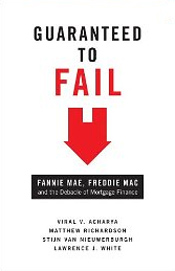Current Economic Woes – Who’s to blame?
Source: Rocklinparks.com
June 4, 2010
I have been reading tripe from democrats and republicans alike blaming the current administration for this country’s financial woes. Allow me to set the record straight on some of it.
1977: Pres. Jimmy Carter signs the Community Reinvestment Act into Law. The law pressured financial institutions to extend home loans to those who would otherwise not qualify. The Premise: Home ownership would improve poor and crime-ridden communities and neighborhoods in terms of crime, investment, jobs, etc.
Results: Statistics bear out that it did not help.
Question: How did the government get so deeply involved in the housing market?
Answer: See below to find out who is covering up their guilt !
1992: Republican representative Jim Leach (IO) warned of the danger that Fannie and Freddie were changing from being agencies of the public at large to money machines for the principals and the stockholding few.
1993: Clinton extensively rewrote Fannie Mae and Freddie Mac’s rules turning the quasi-private mortgage-funding firms into semi-nationalized monopolies dispensing cash and loans to large Democratic voting blocks and handing favors, jobs and contributions to political allies. This potent mix led inevitably to corruption and now the collapse of Freddie and Fannie.
1994: Despite warnings, Clinton unveiled his National Home-Ownership Strategy which broadened the CRA in ways congress never intended.
1995: Congress, about to change from a Democrat majority to Republican, Clinton orders Robert Rubin’s Treasury Dept to rewrite the rules. Robt. Rubin’s Treasury reworked rules, forcing banks to satisfy quotas for sub-prime and minority loans to get a satisfactory CRA rating. The rating was key to expansion or mergers for banks. Loans began to be made on the basis of race and little else.
1997 – 1999: Clinton, bypassing Republicans, enlisted Andrew Cuomo, then Secretary of Housing and Urban Development, allowing Freddie and Fannie to get into the sub-prime market in a BIG way. Led by Rep. Barney Frank and Sen. Chris Dodd, congress doubled down on the risk by easing capital limits and allowing them to hold just 2.5% of capital to back their investments vs 10% for banks. Since they could borrow at lower rates than banks their enterprises boomed.
With incentives in place, banks poured billions in loans into poor communities, often ‘no doc’, ‘no income’, requiring no money down and no verification of income. Worse still was the cronyism: Fannie and Freddie became home to out-of work-politicians, mostly Clinton Democrats. 384 politicians got big campaign donations from Fannie and Freddie. Over $200 million had been spent on lobbying and political activities. During the 1990’s Fannie and Freddie enjoyed a subsidy of as much as $182 Billion, most of it going to principals and shareholders, not poor borrowers as claimed.
Did it work? Minorities made up 49% of the 12.5 million new homeowners but many of those loans have gone bad and the minority home ownership rates are shrinking fast.
1999: New Treasury Secretary, Lawrence Summers, became alarmed at Fannie and Freddie’s excesses. Congress held hearings the ensuing year but nothing was done because Fannie and Freddie had donated millions to key congressmen and radical groups, ensuring no meaningful changes would take place ‘We manage our political risk with the same intensity that we manage our credit and interest rate risks,’ Fannie CEO Franklin Raines, a former Clinton official and current Barack Obama advisor, bragged to investors in 1999.
2000: Secretary Summers sent Undersecretary Gary Gensler to Congress seeking an end to the ’special status’. Democrats raised a ruckus as did Fannie and Freddie, headed by politically connected CEO’s who knew how to reward and punish. ‘We think that the statements evidence a contempt for the nation’s housing and mortgage markets’ Freddie spokesperson Sharon McHale said. It was the last chance during the Clinton era for reform.
2001: Republicans try repeatedly to bring fiscal sanity to Fannie and Freddie but Democrats blocked any attempt at reform; especially Rep. Barney Frank and Sen Chris Dodd who now run key banking committees and were huge beneficiaries of campaign contributions from the mortgage giants.
2003: Bush proposes what the NY Times called ‘the most significant regulatory overhaul in the housing finance industry since the savings and loan crisis a decade ago’. Even after discovering a scheme by Fannie and Freddie to overstate earnings by $10.6 billion to boost their bonuses, the Democrats killed reform.
2005: Then Fed chairman Alan Greenspan warns Congress: ‘We are placing the total financial system at substantial risk’.
Sen. McCain, with two others, sponsored a Fannie/Freddie reform bill and said, ‘If congress does not act, American taxpayers will continue to be exposed to the enormous risk that Fannie Mae and Freddie Mac pose to th[e nation.]
(Note last sentence is left out because it looks as if it had been hacked with page not been checked by provider since its inception over a year ago. The paragraph doesn't make any sense based on all the above comments and writing skills. There are no sentence breaks with periods or capital letters in the last paragraph, as if someone else wrote it and then added it. See for yourself. It's why I have copied the author's comments here, Google saying at the top the page doesn't exist yet it does. I fear this page could become corrupt and pulled from the Web, all the dates and comments lost. So I have copied them here for your review and research.)
Source: Rocklinparks.com
 |
 |